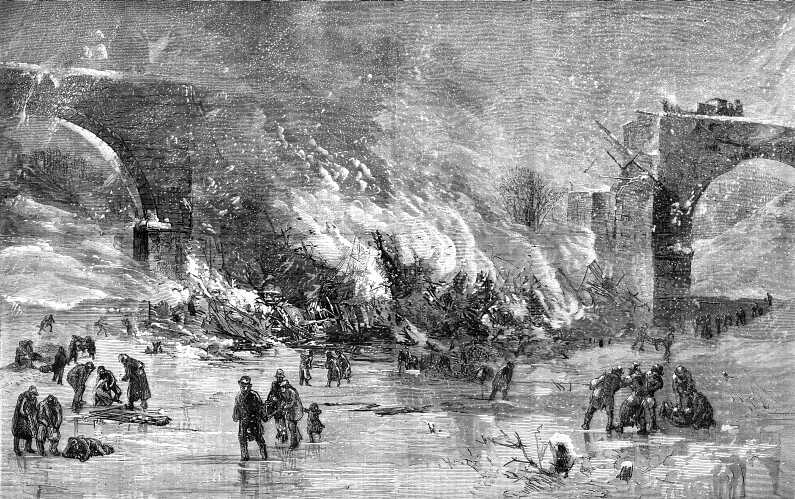|
THE ASHTABULA DISASTER.
Harper's Weekly—January 20, 1877

OUR illustration shows the scene of
the terrible railroad accident at Ashtabula Creek on the night
of December 29, 1876. The train, consisting of eleven cars drawn
by two engines, reached the bridge over Ashtabula Creek about
eight o'clock, and was moving at a low rate of speed. The engines
had crossed in safety, when the bridge, without warning, gave
way, and the whole train, with the exception of the leading engine,
the couplings of which broke, was precipitated into the ravine,
a distance of seventy-five feet. The banks are steep, and the
furious snow-storm that had been raging for several hours rendered
it difficult for those who hastened to the scene of the disaster
to reach the wreck. To add to the horror of the situation, the
cars took fire from the stoves, and many passengers who were not
killed outright by the fall were burned to death. Imprisoned by
heavy fragments of the broken cars, or unable to move on account
of injuries, men, women, and children met death in this agonizing
form. Some, it is supposed, were drowned.
Help arrived early from Ashtabula village, but nothing could
then be done to save life, except to remove the wounded, who had
already been taken from the cars, to places where they could have
surgical attention. The heat from the burning wreck was intense,
and in the confusion of the moment the means which might have
been used to extinguish the flames were not thought of until too
late. At the water-works, within 150 yards of the burning cars,
lay 500 feet of hose, the coupling of which exactly fitted a plug
within pistol-shot of the fire, the plug being connected with
a powerful pumping apparatus, and there being sixty pounds of
steam in the pump boiler. The hose could have been pouring a stream
on the fire within five minutes but for somebody's fault or stupidity.
A survivor of the disaster, Mr. BURCHELL,
of Chicago, describes the scene in vivid colors: "The first
thing I heard was a cracking in the front part of the car, and
then the same cracking in the rear. Then came another cracking
in the front louder than the first, and then came a sickening
oscillation and a sudden sinking, and I was thrown stunned from
my seat. I heard the cracking and splintering and smashing around
me The iron-work bent and twisted like snakes, and every thing
took horrid shapes. I heard a lady scream in anguish, I Oh! help
me!' Then I heard the cry of fire. Some one broke a window, and
I pushed the lady out who had screamed. I think her name was Miss
BINGHAM. The train lay in the valley in
the water, our car a little on its side, both ends broken in.
The rest of the train lay in every direction, some on end, some
on the side, crushed and broken. The snow in the valley was nearly
to my waist, and I could only move with difficulty. The wreck
was then on fire. The wind was blowing from the east, and whirling
blinding masses of snow over the terrible ruin. The crackling
of the flames, the whistling wind, the screaming of the hurt,
made a pandemonium of that little valley, and the water of the
freezing creek was red with blood or black with the flying cinders.
The number of persons killed can not be accurately stated,
as it is not known exactly how many there were on the train, and
it is supposed that some bodies were entirely consumed in the
flames. The official list of the killed and those who have died
of their injuries, gives the number as fifty-five, but it is supposed
to be somewhat higher.

On this page we give a diagram showing the construction of
the bridge, which was of iron. It was built about eleven years
ago, and was supposed to be a structure of great strength. It
had been, tested with the weight of six locomotives; heavy trains
had crossed on both its tracks at the same time; it was believed
to be well constructed of the best materials. Yet suddenly it
fell under a weight far below its tested strength. No wonder that
the travelling public anxiously inquire, "What was the cause?"
Was it improperly constructed? Was the iron of inferior quality?
After eleven years of service, had it suddenly lost its
strength? Or had a gradual weakness grown upon it unperceived?
Might that weakness have been discovered by frequent and proper
examination? Or was the breakage the sudden effect of intense
cold? If so, why had it not happened before in yet more severe
weather? Is there no method of making iron bridges of assured
safety? And who is responsible (so far as human responsibility
goes) for such an accident—the engineer who designed the
bridge, or the contractor, or the builders, or the railroad corporation?
Was the bridge, when made, the best of its kind, or the
cheapest of its kind? Was the contract for building "let
to the lowest bidder," or given to the most honest, thorough
workmen? These and a hundred similar queries arise in every thoughtful
mind, and an anxious community desire information and assurance
of safety. The majority of people can not, of course, understand
the detailed construction of bridges, but they do desire confidence
in engineers, builders, contractors, manufacturers, who have to
do with the making of them, and in the railroad companies, into
whose hands they are constantly putting their own lives and the
lives of those dearest to them.
Railroad Accidents—Chapter 11
- copyright 1879
Railroad Accidents
| Contents Page
|







